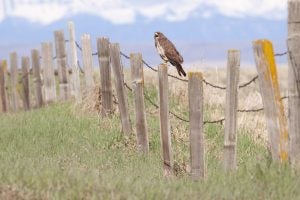
A pilot project for Swainson’s hawk is creating high-quality nesting habitat on a 4,000-acre farm in San Joaquin County.
Landowners and environmentalists both grapple with the same question: In the midst of uncertainty, what is the most effective way to reconcile short-term and long-term needs for wildlife habitat?
For example, it can be risky to invest in permanent conservation on a property vulnerable to climate change, but failing to protect existing habitat in the face of uncertainty is an existential threat to species like the Swainson’s hawk.
Fortunately, new habitat accounting tools are emerging that bring more certainty to conservation planning, which helps landowners make effective management decisions for their property, helps biologists design effective restoration plans and ultimately helps wildlife thrive.
[Tweet “We need to get creative to protect wildlife in the face of climate risk. Here’s why, via @GrowingReturns.https://edf.org/79H”]
New tools in the toolbox

Despite the pressures of climate change, the Swainson’s hawk has successfully adapted to agricultural lands in the Central Valley. Grasslands, hay crops and row crops provide habitat for rodents, the hawk’s primary food source, but that food source is disappearing as row crops are converted to permanent orchards and vineyards.
Environmental Defense Fund (EDF) is working to meet the need for flexible conservation solutions that can adapt with a changing climate and account for uncertainty.
The Central Valley Habitat Exchange in California, for example, has developed Habitat Quantification Tools for at-risk species like the Swainson’s hawk. The tools measure how well a property provides for all life stages necessary for survival and reproduction. Combined with high performance standards and third-party verification, the goal of the exchange is to enhance and protect habitat on farms and ranches.
We are currently working on a pilot project for Swainson’s hawk in San Joaquin County on a 4,000-acre farm that produces a mix of organic and conventional crops within a rotation of irrigated pasture. Substantial high-quality nesting habitat on the property supports several pairs of hawks, and dozens of birds are frequently observed hunting for rodents as flood irrigation exposes their prey.
This property is one of the largest tracts of prime hawk habitat in the San Francisco-San Joaquin Bay Delta, a region with accelerated conversion of row crops to orchards and vineyards. Though protected by a series of levies, the property is susceptible to sea level rise, and regulatory agencies have advised the county not to invest in a permanent conservation easement. Even so, that doesn’t mean this site can’t provide habitat benefits for the bird.
Flexible conservation timelines
Where permanent conservation protections aren’t an option, it’s possible to protect valuable habitat for a shorter time frame. In a partnership with NatureServe, EDF has been examining five climate change models for select species in the Central Valley. By analyzing the models’ predictions, we can identify where habitat is expected to be stable, to shrink or to expand as climate changes.
This information is useful in understanding where permanent habitat protections make sense, and where providing 20- to 50-year protections makes more sense. This is the case with the property in San Joaquin County.
To stabilize current bird populations, we need a way to take advantage of critical conservation opportunities today yet retain flexibility to adapt to evolving climate conditions. Key ideas worth considering include:
- Carving out climate change adaptation funds in state water and park bonds to establish term easements or performance contracts on properties with high-quality, at-risk habitat. While term projects are sometimes allowed, preference is usually given to permanent protection.
- Allocating a portion of fees collected to offset the impacts of development to term contracts of 15 to 20 years to stabilize existing habitat. This would require a change in guidance and precedence from regulatory agencies. While this may be seen as risky, our current approach is failing the species we’re all working to protect.
- Establishing a Resource Conservation Investment Strategy (RCIS), as allowed by a new California law, AB 2087. Though in the pilot phase, an RCIS might serve as a laboratory to finally devise a conservation strategy for these types of projects.
Creative and adaptive conservation approaches are possible. With the commitment of state and federal agency staff, conservation organizations, scholars and landowners, I’m confident we can address near-term and long-term habitat challenges in a cooperative and pragmatic way.
Related:
How healthy riparian forests benefit California ranchers >>
California’s new law means more bang for every buck invested in wildlife >>
Birds, snakes and butterflies: Farming for more than crops and cash >>









